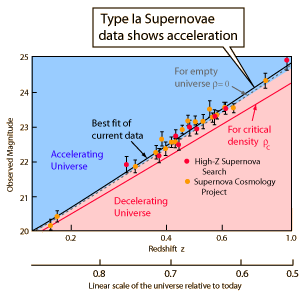Dark Energy
One of the observational foundations for the big bang model of cosmology was the observed expansion of the universe. Measurement of the expansion rate is a critical part of the study, and it has been found that the expansion rate is very nearly "flat". That is, the universe is very close to the critical density, above which it would slow down and collapse inward toward a future "big crunch". A big conceptual problem has been that we haven't been able to observe more than a fraction of that density in the form of ordinary matter. The WMAP projection of the ordinary baryonic matter is only 4.4% of critical density, and only 27% even when the projected "dark matter" is included. So we are left having to account for the remaining 73% of the effective density, and the name chosen is "dark energy".
One of the great challenges of astronomy and astrophysics is distance measurement over the vast distances of the universe. Since the 1990s it has become apparent that type Ia supernovae offer a unique opportunity for the consistent measurement of distance out to perhaps 1000 Mpc. Measurement at these great distances provided the first data to suggest that the expansion rate of the universe is actually accelerating. That acceleration implies an energy density that acts in opposition to gravity which would cause the expansion to accelerate. This is an energy density which we have not directly detected observationally - hence "dark energy".
If we take the WMAP value for critical density at
 | Measurement of the redshift of distant type Ia supernovae is one of the types of evidence for and accelerated expansion of the universe and hence for dark energy. |
| The density parameter Ω |
Reference
Carroll & Ostlie
Ch 29
Conselice
| HyperPhysics***** Astrophysics | R Nave |